Thanksgiving Cactus Care Guide: Grow Healthy Plants That Bloom Over The Holidays
Grow thriving Thanksgiving cactus plants that reliably rebloom, with this expert guide to creating the ideal growing conditions and solving common problems.

With its exotic flowers that last for months, the Thanksgiving cactus (Schlumbergera truncata) is a holiday favorite that looks great in homes year-round. The plants are easy to grow, and Thanksgiving cactus care is mostly centered around encouraging blooms at the right time.
One of the main types of holiday cactus, the Thanksgiving cactus plant is a close relative of the ever-popular Christmas cactus. Both are native to the tropical forests of Brazil and have a similar appearance, although they bloom at slightly different times. The flowers appear around their namesake holidays, which makes them popular gifts.
If you have some experience with Christmas cactus care, then you will be relieved to know that the care of Thanksgiving cactus is very similar. It's easier than Easter cactus care – the other well-known holiday cactus that blooms in the spring.
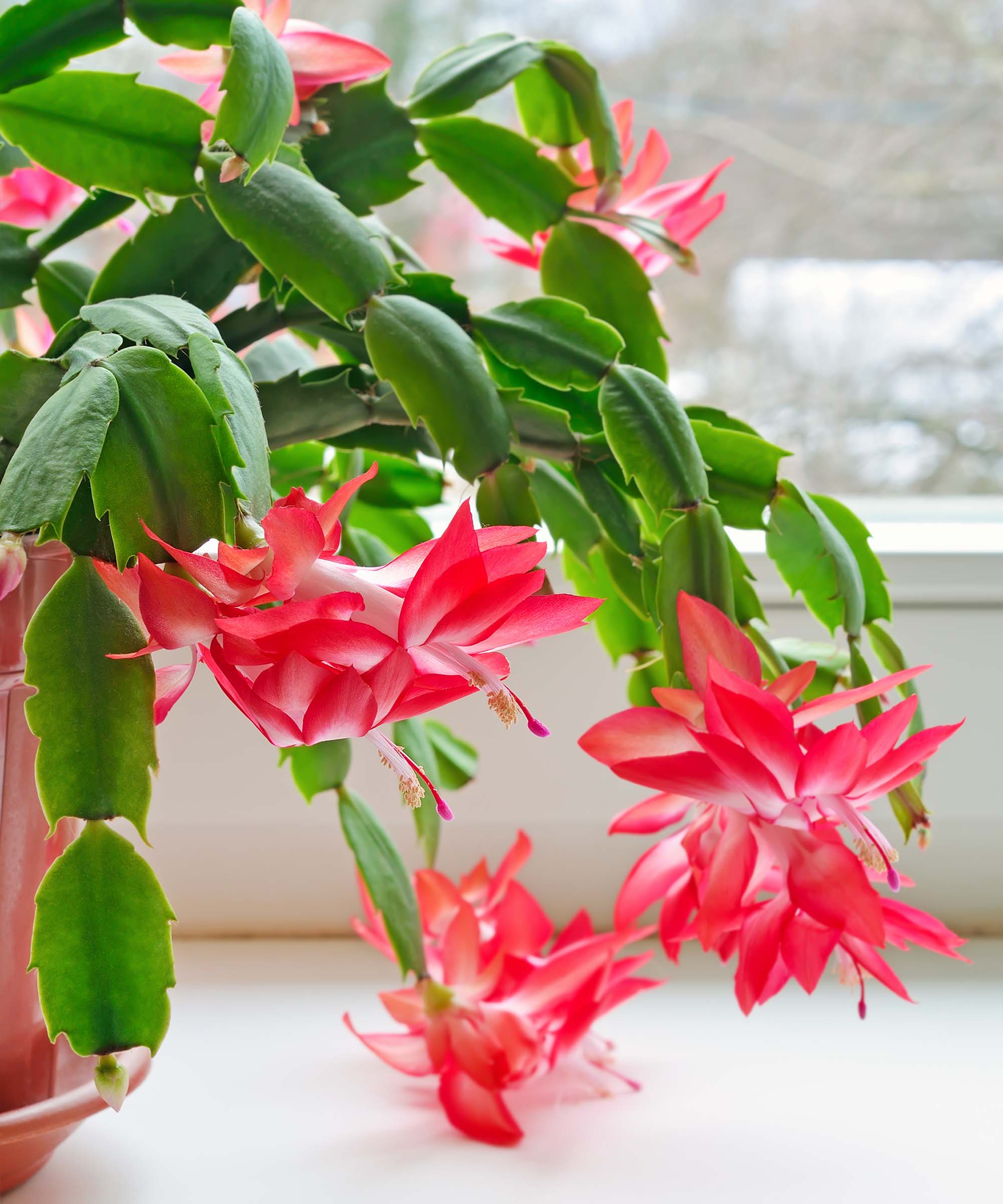
What Does a Thanksgiving Cactus Look Like?
The Thanksgiving cactus can be identified by luscious green leaves that are broad and flat with slight serrations on the edges. They are sometimes said to resemble crab claws. Meanwhile, the Christmas cactus has smoother-edged leaves.
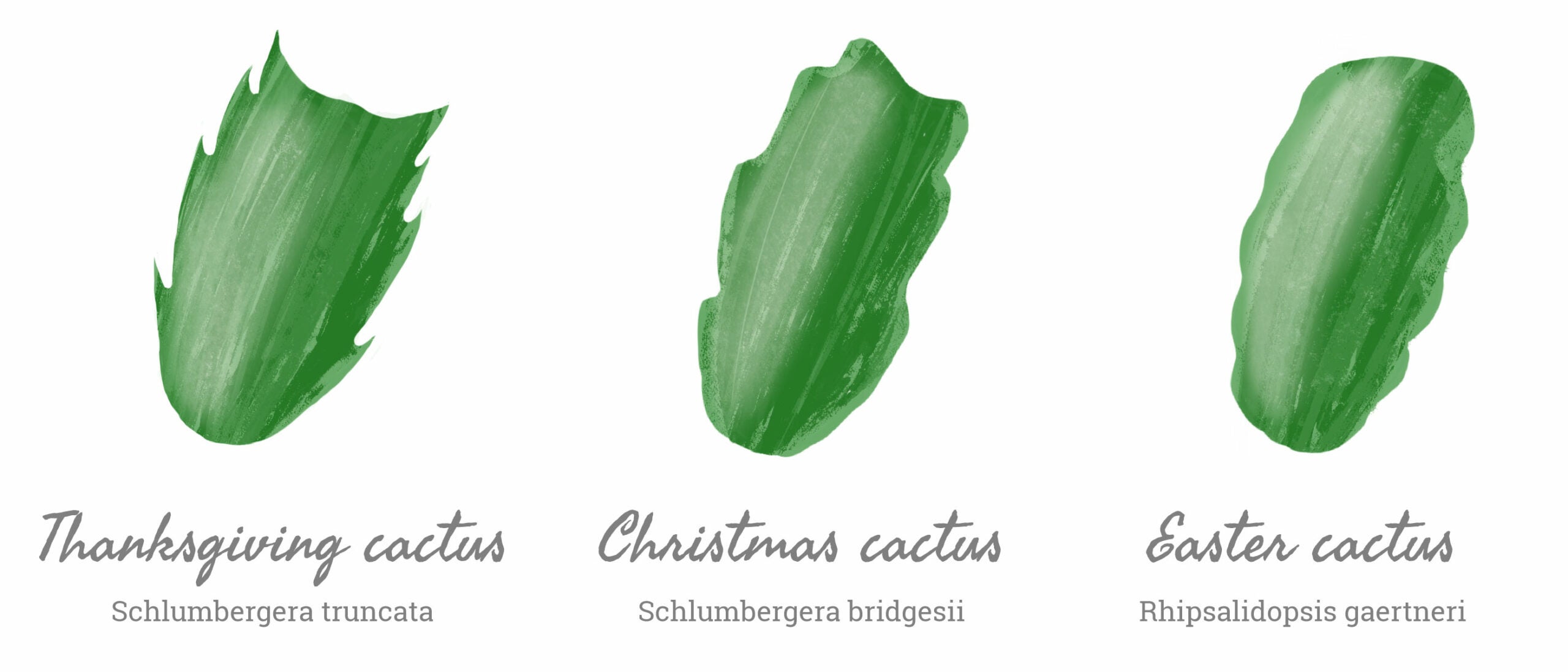
Quick Facts
Botanical name: Schlumbergera truncata
Height: 6-24 inches (15-60cm)
Spread: 12-24 inches (30-60cm)
Sun exposure: Bright, indirect
Soil requirements: Well-draining potting medium
Hardiness zones: USDA Zones 10-12
When to plant: Spring or summer
The flowers that emerge in fall are similar in appearance to fuchsia blooms and resemble a flower within a flower. They come in hues of yellow, white, pink, or red and last for two to four months.
Look closely at the blooms and you will see that Thanksgiving cactus flowers have yellow anthers, while the flowers of Christmas cacti flowers have purple-brown anthers.
The plant has an upright growth habit, which makes it ideal for table centerpieces. When the stems grow longer, they will naturally cascade, creating an elegant form.
Sign up for the Gardening Know How newsletter today and receive a free copy of our e-book "How to Grow Delicious Tomatoes".
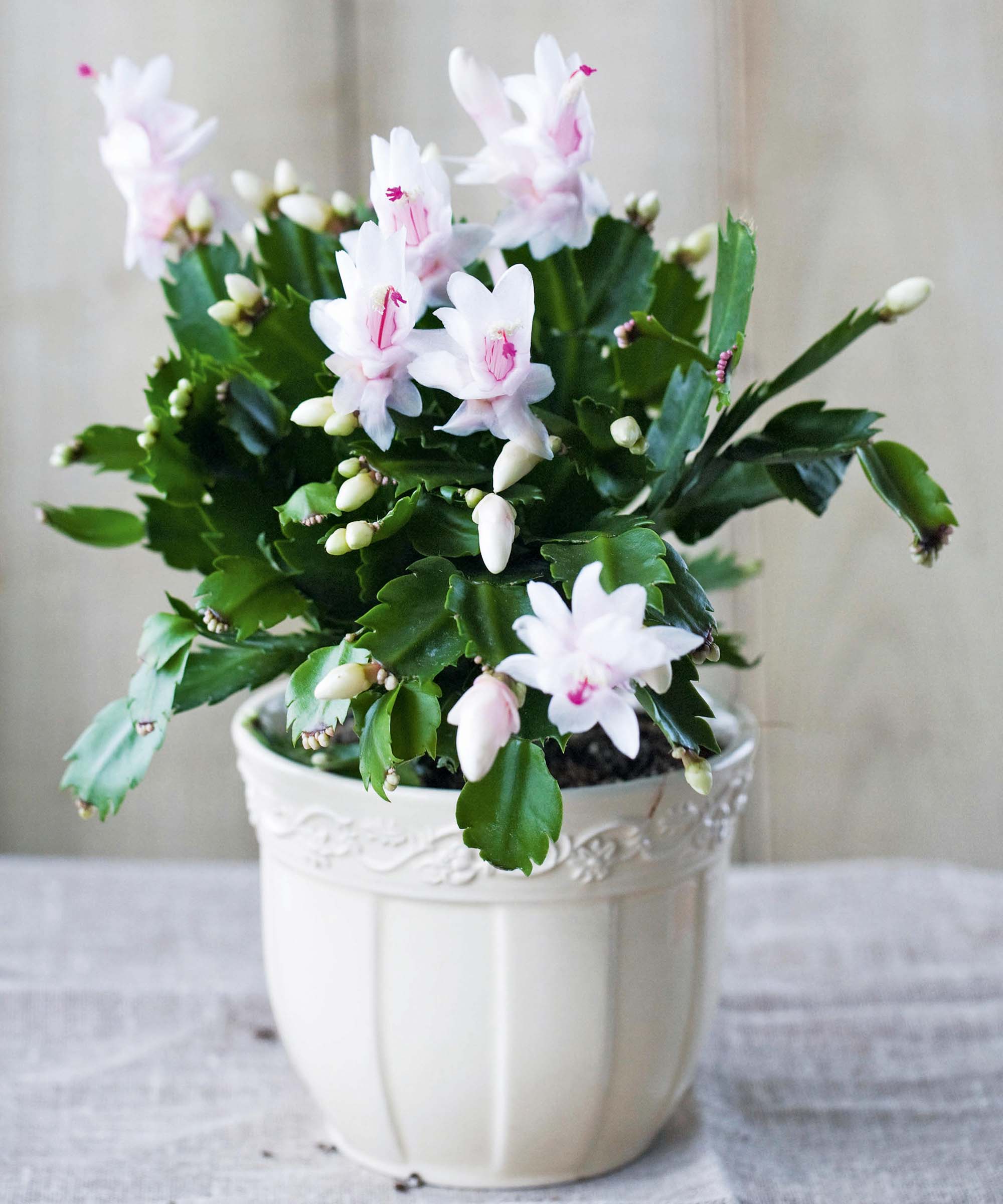
Thanksgiving Cactus Care Guide
Learning how to care for a Thanksgiving cactus is easy if you appreciate the plant for its greenery, but encouraging it to flower takes a bit more effort.
We tend to think of cacti as desert-dwellers, but Schlumbergera truncata is a tropical epiphytic plant, which means it grows on trees or rocks, taking nutrients from the surrounding environment.
The secret to successful Thanksgiving cactus care is to recreate the plant's natural growing conditions as far as possible indoors, providing similar light levels, temperature, and moisture.
In its natural habitat, Thanksgiving cactus experiences cool temperatures and short daylight hours over fall and winter. If you live in a region with no frost, you can leave the cactus outside to experience these conditions. But in cooler USDA hardiness zones, the Thanksgiving cactus must overwinter indoors, which will be artificially lighter and warmer.
Light Requirements
The Thanksgiving cactus thrives in bright but indirect sunlight – ideally positioned close to an east or north-facing window. In fall and winter, the plant can be located to receive more direct light than during the spring and summer.
For plants to rebloom, they require a period of short days, experiencing 12-14 hours of uninterrupted darkness each night. This must continue for at least six weeks before flowering.
If you want the plant to bloom over Thanksgiving, then in September – or early October at the latest – move it to a cool room that is not used in the evening, so the plant is not disturbed by artificial lighting.
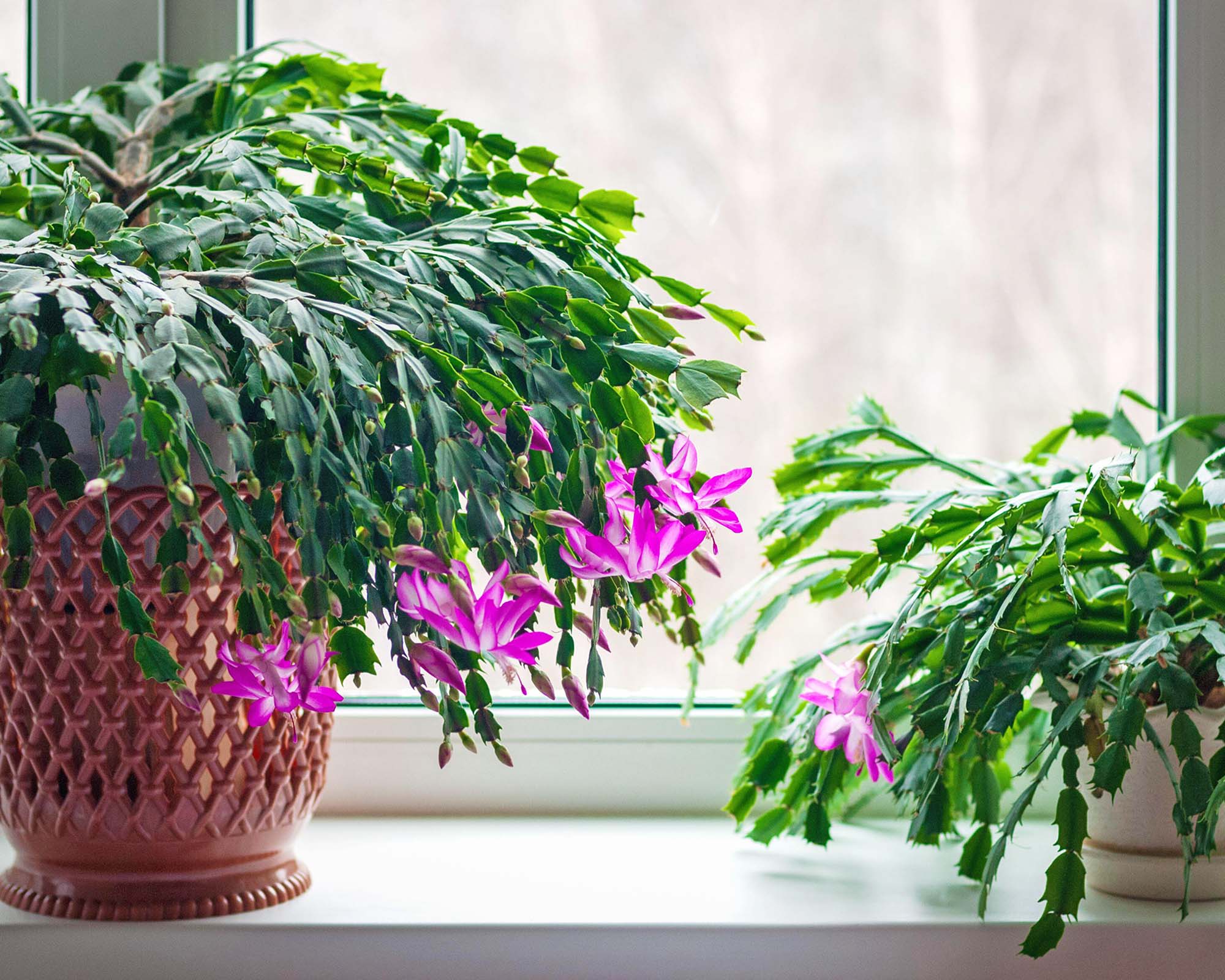
Temperature Range
Though it can survive temperatures as low as 40°F (4°C) over the colder months, the Thanksgiving cactus will not flower under these conditions.
To promote blooms, Schlumbergera truncata should be maintained at a daytime temperature of 61-68°F (16-20°C) during the fall, and 55-60°F (13-15°C) at night.
In the warmer summer months, Thanksgiving cactus can tolerate temperatures of 70-80°F (21-27°C).
How Often to Water a Thanksgiving Cactus
One of the most crucial aspects of Thanksgiving cactus plant care is watering. These tropical plants should not be allowed to fully dry out; however, excess water at the roots can cause rotting and fungal issues.
On average, Thanksgiving cacti require watering once or twice a week. Before doing so, push your finger into the soil to feel whether it has dried out – if the top third of the soil is dry, then water thoroughly. Allow the water to drain through to avoid soggy roots. Reduce watering over winter, once the cactus has finished blooming.
As an epiphyte, Schlumbergera truncata often has exposed roots and gathers much moisture from the air. It thrives in humidity of 50-60%. To raise humidity for houseplants, place a tray of pebbles filled with water beneath the pot, or invest in a houseplant humidifier.
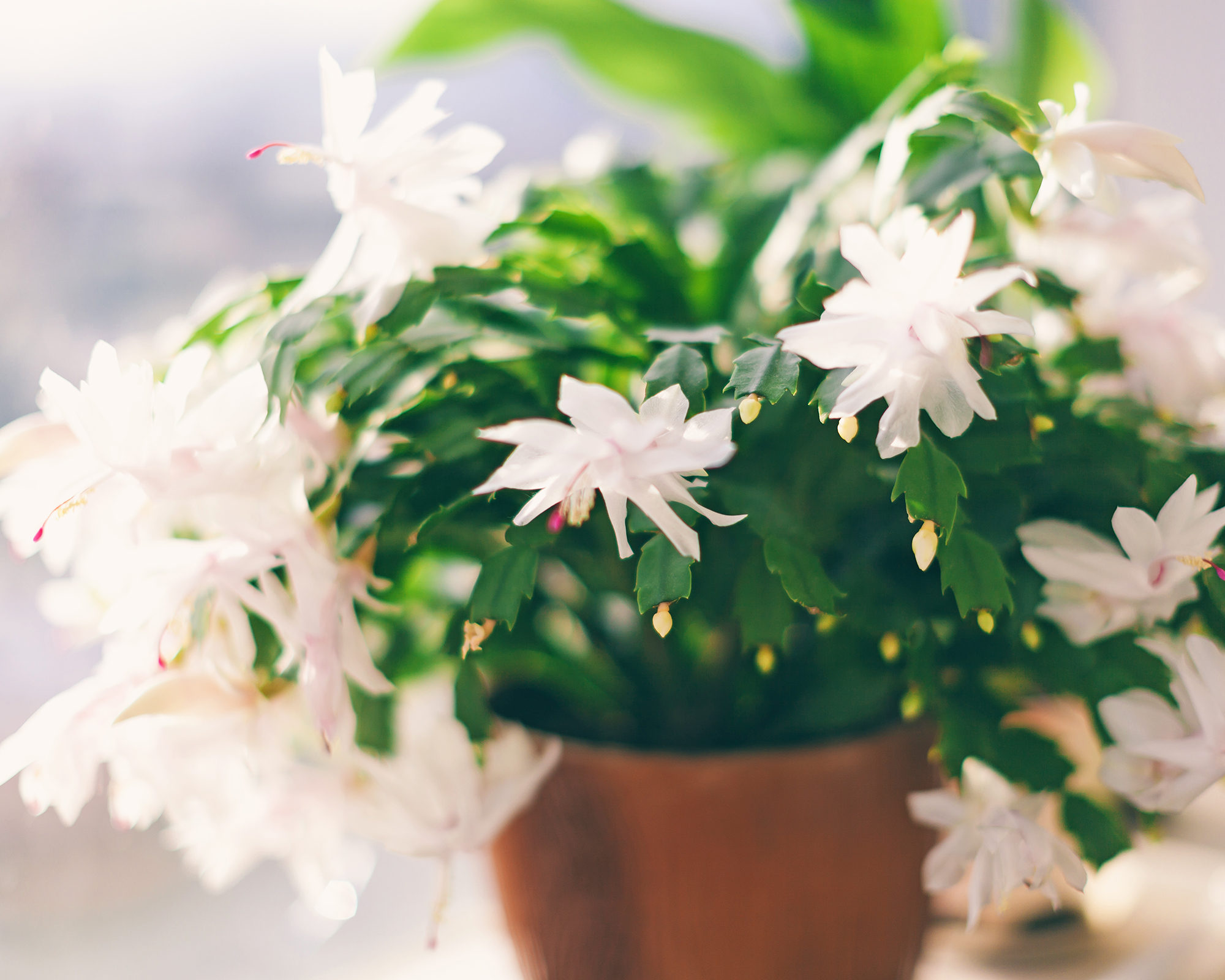
When to Fertilize
Begin fertilizing Thanksgiving cactus plants once they start to develop new growth in late winter or early spring and continue until the end of summer.
Fertilize once a month using a houseplant feed diluted to half strength. In the fall, you can switch to a low-nitrogen food to promote flowering.
Thanksgiving cacti have higher magnesium needs than most plants, so it's a good idea to occasionally apply Epsom salts – diluted one teaspoon per gallon of water. Do this no more than once a month, and not in the same week as fertilizing.
Repotting Thanksgiving Cactus
Repotting a Thanksgiving cactus is an important aspect of care, but should only be done when really needed. The plants flower best when pot-bound.
On average, plants need to be repotted every three to five years. Ideally, transplant them in the winter, after the cactus has finished flowering. However, repotting is also a good idea if the plant is in poor health and other causes have been eliminated.
Thanksgiving cactus isn't the easiest houseplant to repot due to its sharp spines, fragile stems, and weight of mature plants. Wear gloves and take care to avoid damaging the plant – although you can remove any dead or diseased plant material.
Transplant to a new pot 1-2 inches bigger in diameter with drainage holes, and use a well-draining potting mix.
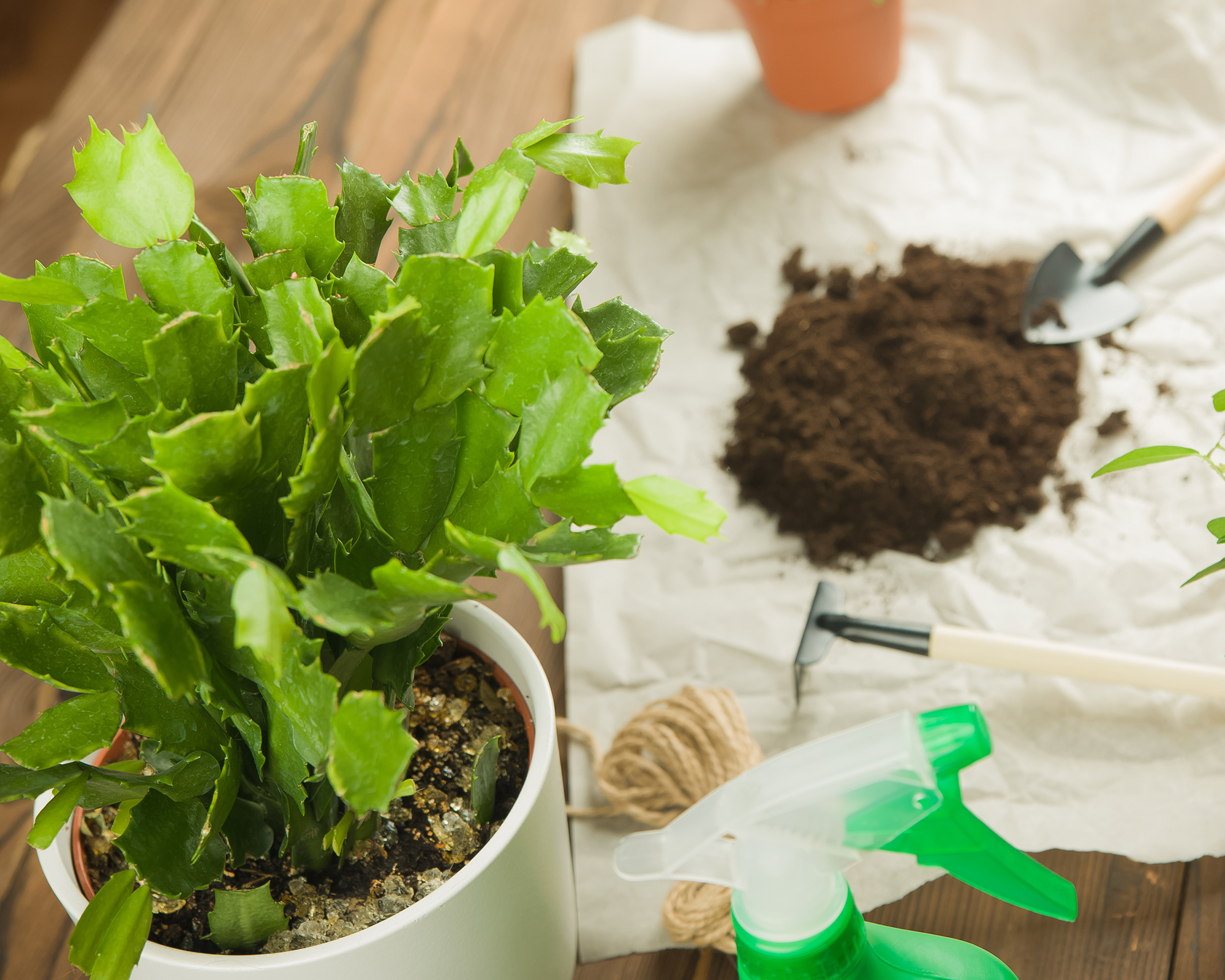
Best Soil Mix
Potted Thanksgiving cactus plants need well-draining soil and a pot with plenty of drainage holes. Either use cactus potting soil, or make your own basic mix by combining roughly two parts potting soil with one part perlite.
You can also mix one part potting soil with two parts peat moss and one part perlite, or combine potting soil with orchid potting mix or pine bark.
How to Prune a Thanksgiving Cactus
Prune a Thanksgiving cactus shortly after it has finished blooming. This will help the plant to branch out and form healthy new stems.
Simply twist the stems between a segment to break them off, or use sharp scissors or hand pruners. Trimming the stems just one to two segments from the end will help the plant fill out.
You can trim plants by up to one-third each year. Any more could be detrimental to plant health.
Deadheading a Thanksgiving cactus will keep the plant neat and tidy, and allow it to put its energy towards forming new growth. Simply twist off spent flowerheads with your fingers.
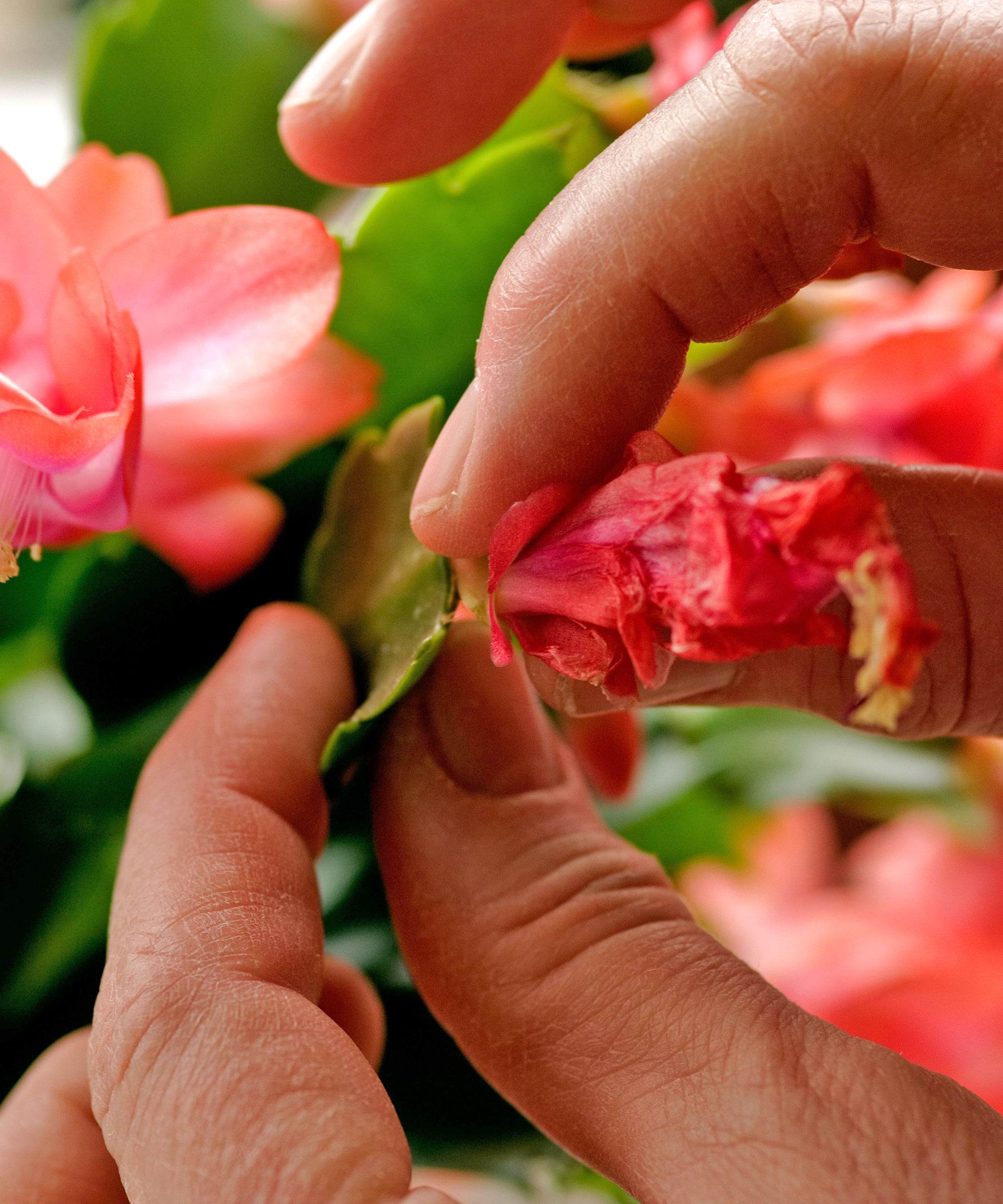
Propagating Thanksgiving Cactus
Propagating Thanksgiving cactus plants is a fun and easy way to make gifts for the holidays. What a unique host or hostess gift idea to try this holiday season!
Snip off a stem with 2-5 sections and leaves. Dust the end with fungicide and allow it to callus for a week in a dry location. Fill a small clay pot with vermiculite or perlite mixed with potting soil. Alternatively, you can use damp sand.
Push the callused end into the mixture and place the pot in bright but indirect light. Tent over the cutting with a plastic bag and remove it for an hour each day to let in air.
In approximately three weeks, the cutting will have rooted and you will have a brand new plant. Growing a Thanksgiving cactus to blooming stage will take a couple of years.
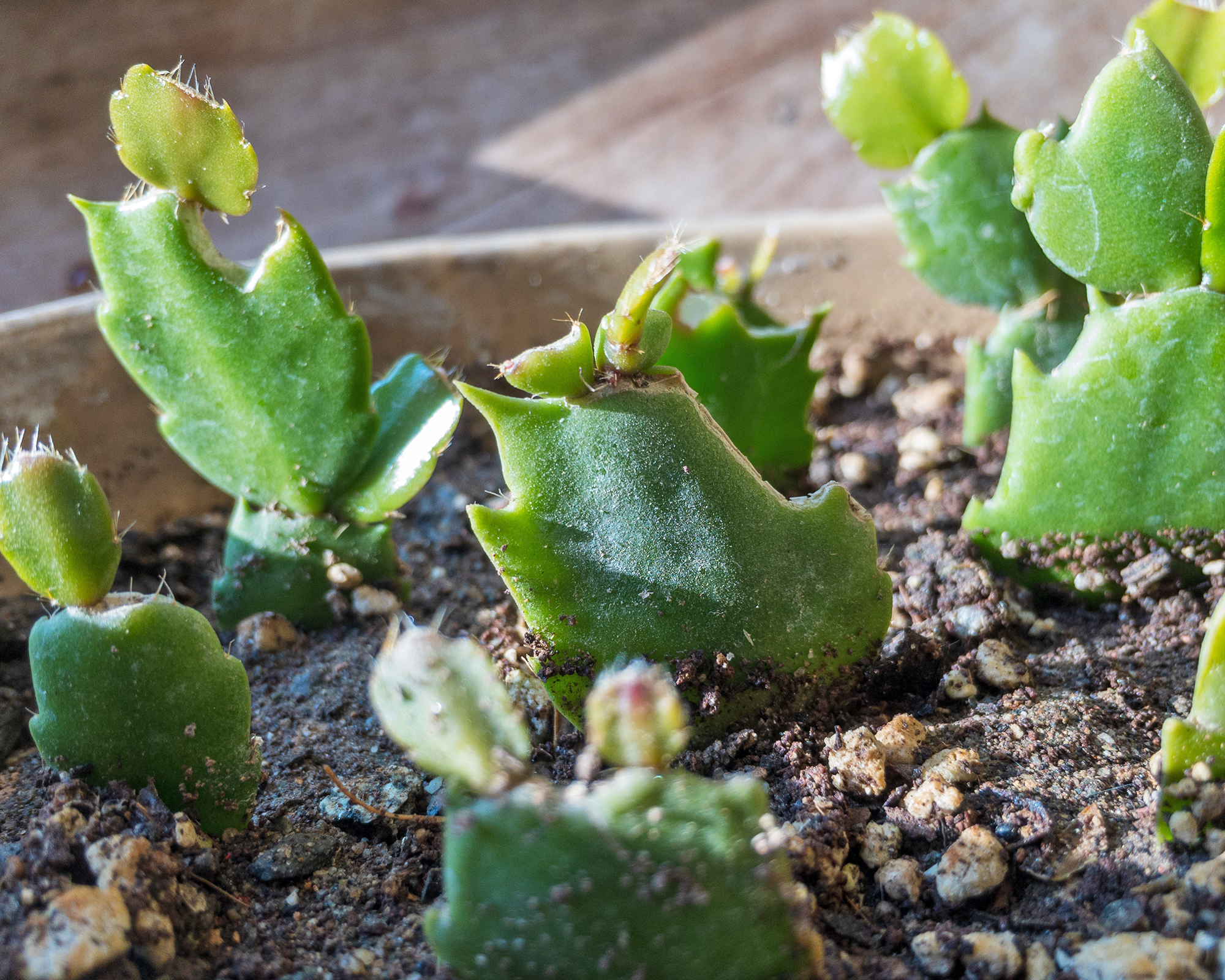
Common Problems
When properly cared for, the Thanksgiving cactus suffers few problems. However, there are some potential issues to look out for:
- Root rot is the most common issue, and is usually a result of overwatering or poor drainage. Act fast to trim away affected roots, wash the remaining roots, and apply a natural fungicide, such as cinnamon. Allow the roots to dry out overnight before repotting in fresh free-draining soil. In the future, only water once the potting mix has begun to dry out. If the plant is too far gone, take cuttings and propagate a new plant.
- Dropping buds is another common issue that can be due to numerous factors, including under or overwatering, incorrect light, or temperature changes. However, if the plant has a lot of buds and just loses a few, this is usually nothing to worry about.
- Dropping leaves is usually caused by overwatering, drainage issues, or incorrect temperatures.
- Thanksgiving cactus leaves turning purple may be caused by poor fertilizing, a need for repotting, or sunburn.
- Wilting or limp plants are usually caused by underwatering or too much direct sunlight. Though it could also be a sign of root rot.
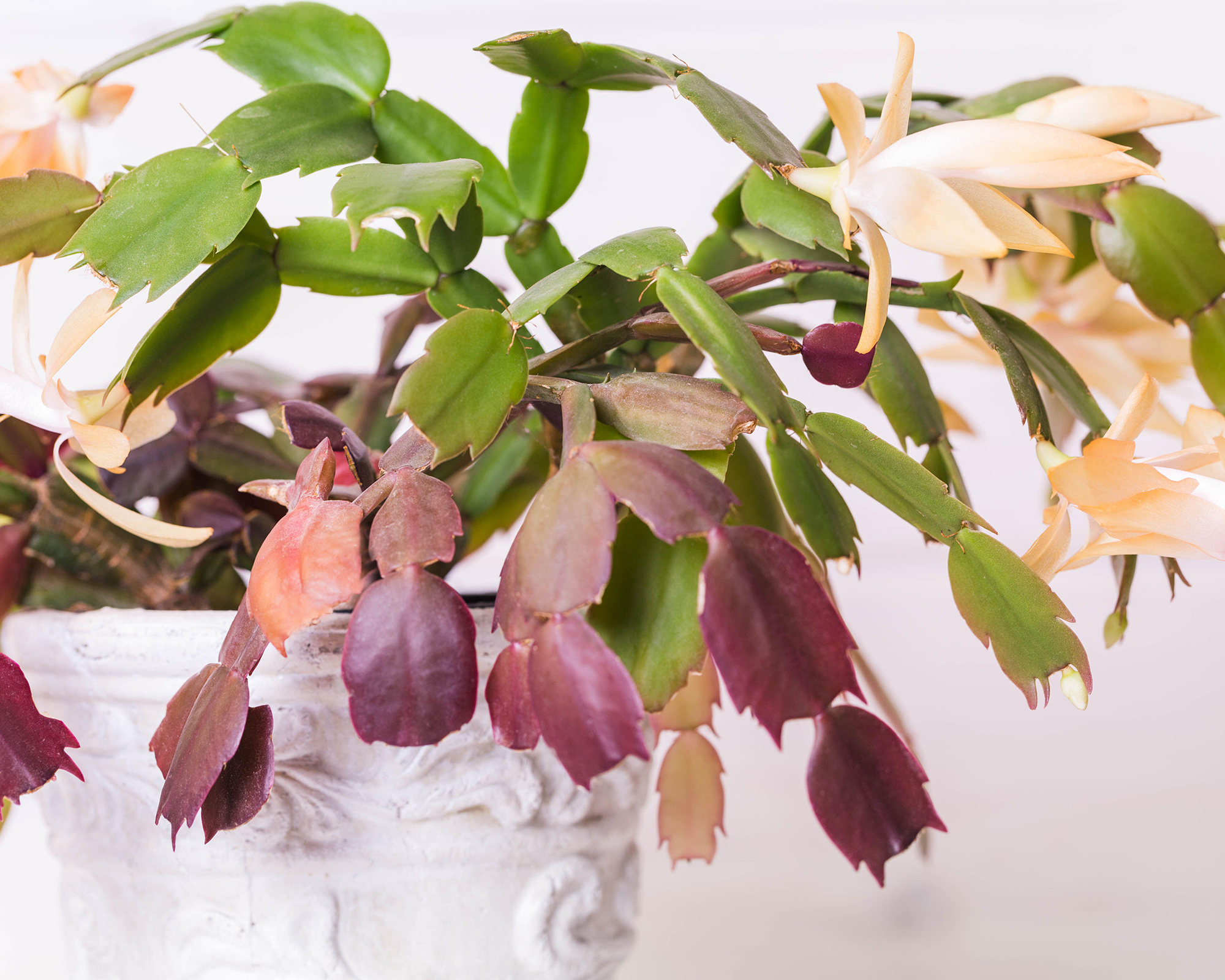
Pests
While the Thanksgiving cactus is not prone to pest infestations, it can happen, so be on the lookout for these critters:
- Spider mites are tiny and difficult to spot, but look for fine webbing or specks on the leaves. Where an infestation is present, clean the leaves and use an insecticidal soap spray or neem oil foliar spray.
- Aphids are sap suckers that leave sticky honeydew on the leaves and may cause irregular growth and poor plant health. You can gently rinse the plant leaves to wash them off and treat them with neem oil or insecticidal soap.
- Mealybugs suck sap from the leaves and produce a protective cottony substance on the leaves and stems, as well as a sticky sap that can cause mold. Wipe them off and treat them with insecticidal soap or rubbing alcohol.
- Scale insects often appear as bumps on stems and the undersides of leaves. They suck sap from plants and can do damage in large numbers. Scrape or wipe them off and treat them with insecticidal soap or neem oil.
- Fungus gnats are small flies that breed in wet soil. Avoid overwatering and treat with insecticidal soap spray. Where fungus gnats are persistent, repot the plant into fresh potting mix.

Melanie is an experienced gardener and has worked in homes and gardens media for over 20 years. She previously served as Editor on Period Living magazine, and worked for Homes & Gardens, Gardening Etc, Real Homes, and Homebuilding & Renovating. Melanie has spent the last few years transforming her own garden, which is constantly evolving as a work in progress. She is also a passionate organic home grower, having experimented with almost every type of vegetable at some point. In her home, Melanie tends to an extensive houseplant collection and is particularly fond of orchids.
- Bonnie L. GrantWriter
- Amy DraissDigital Community Manager